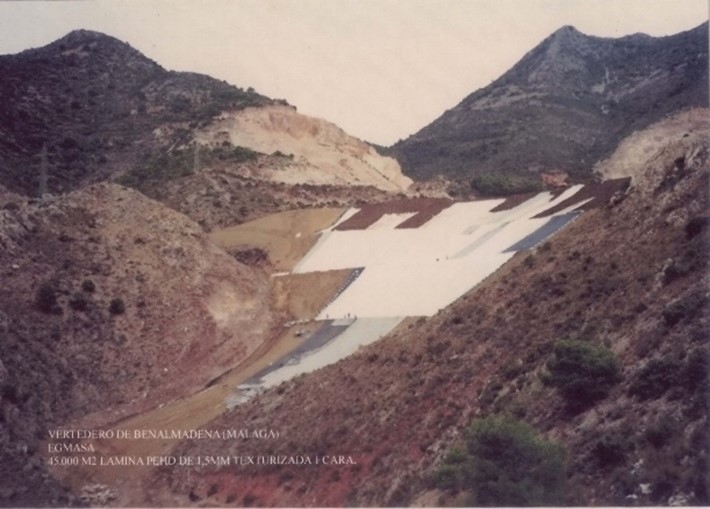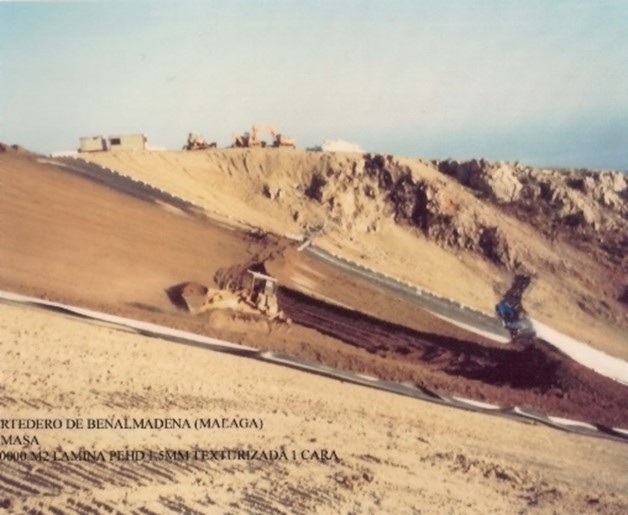The work is located on a narrow ravine in the municipality of Benalmádena, Málaga, in the vicinity of the Autopista del Sol from where it can be seen.
Its aesthetic impact is therefore very considerable. In addition, the steep slope and the fact that on one side of the ravine there is a torrent channel that in the rainy season could cause serious instability to the waste deposit.
Finally, the proximity to urban areas, including uncontrolled buildings at the foot of the slope, and the absence of adequate leachate control made it advisable to treat the problem as a whole, including permanent sealing of the waste, complete stabilization of the foot of the slope by treating the riverbed against erosion with riprap and finally revegetation to cushion the aesthetic impact on the area.
The area to be treated is about 35,000 m² in slopes to which must be added another 18,000 m² on the upper platform. The total slope is about 80 m with an average gradient of 25º.
On the upper platform there are chimneys of the degassing system distributed every 15 m approximately.

The solution
The solution designed for the sealing consisted of a Reinforcement Support on a slope profile based on 5 berms between 3.5 and 4 m wide, with 4 slopes between 25 and 36 m long and an average slope angle of 27°.
The anchorage in the berms has been designed by pure friction without trench, even in the upper slope, to facilitate continuity between layers of geosynthetics. The backfill thickness for this purpose in berms was 1.4 m.
On the inner side of each berm there is a drainage pipe with an outlet to the torrent channel for the rapid evacuation of any infiltration water from the interior of the slope.
The geosynthetic solution consisted of a 1.50 mm thick geomembrane textured on both sides, on which a draining geocomposite with a polyamide core and two 110 gr/m² separation geotextiles sewn to the core were placed, and finally a polyester reinforcement geotextile with a breaking strength of 250 KN/m, in charge of the stability of the whole.
The presence of the textured sheet provides considerable additional safety to ensure the resistant behavior of the draining geocomposite placed on it, although it is not effective in the calculation of the reinforcement dimensioning because the limiting plane of the smallest friction angle becomes the existing one between the reinforcement geotextile and the upper geotextile of separation of the same draining geocomposite.
The final cover is composed of 30 cm of clay and topsoil with the surface covered by an erosion control felt made of 50% straw and 50% coconut fiber.
The choice of this type of material was based mainly on the fact that, given its relative instantaneous impermeability provided by the straw, it allows for less erosion to be expected in the face of stormy rain phenomena that occur in an area so close to the sea.
The execution
The execution has not been without difficulties.
First of all, the berms were not accessible from both ends, only from one, and in the case of the first one, the only access road was a lateral slope of the landfill that had to be previously rehabilitated due to its rocky nature.
This layout and the continuous wind due to the proximity to the sea made it difficult not only to place the geosynthetics but also the earth, which had to be coordinated. Despite this, the work was completed in a record time of two months.
It was decided to carry out the work with two teams. The 18,000 m² upper platform was completed in 5 days with a team of 4 workers. Once it was completed, including its backfilling, the slopes were attacked in two phases. A first one corresponding to the upper and next berm, with a total area of 23,000 m², covered in 10 days with two teams of 5 people.
The geosynthetics pit was then interrupted and the earth backfilling was carried out on the only side of the berm that was accessible. Finally, the next 12,000 m² were covered in 6 days with the same 10 workers.
One issue to highlight was the filling of the covering soil that, as a consequence of the slope angle being very close to the angle of residual friction with the geotextile, sliding occurred at first. The advance of the paving/compaction machinery from bottom to top, the humidity of the soils and the cohesion formed over time at the interface of the geotextile, together made it possible to reach the current state of stability.
A noteworthy incident was the detachment of two geotextile cloths together with their covering soil, with a clean exit of their anchorage at the crest, consisting of 10 m of length due to pure friction, although without product breakage. The explanation, apart from corroborating the accuracy of the anchorage calculation, was that stresses much higher than those adopted in the calculation were generated as a consequence of an accumulation of soil at the crest of the slope prior to its spreading. An estimate of the weight of soil spillage from the pile accumulated there indicated a volume twice that of the design.
The conclusion to be drawn is that this area must always be the object of special care, both to avoid accumulation of materials and to prevent the passage of machinery that could damage the reinforcement.





